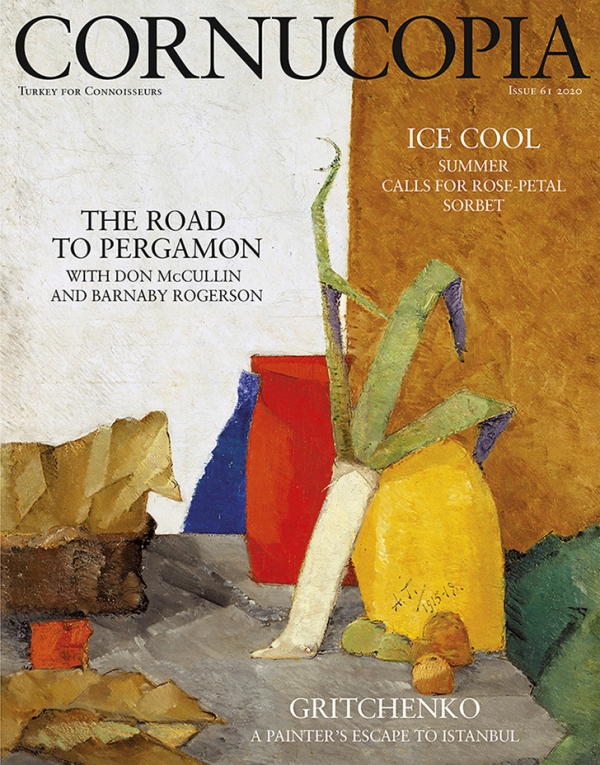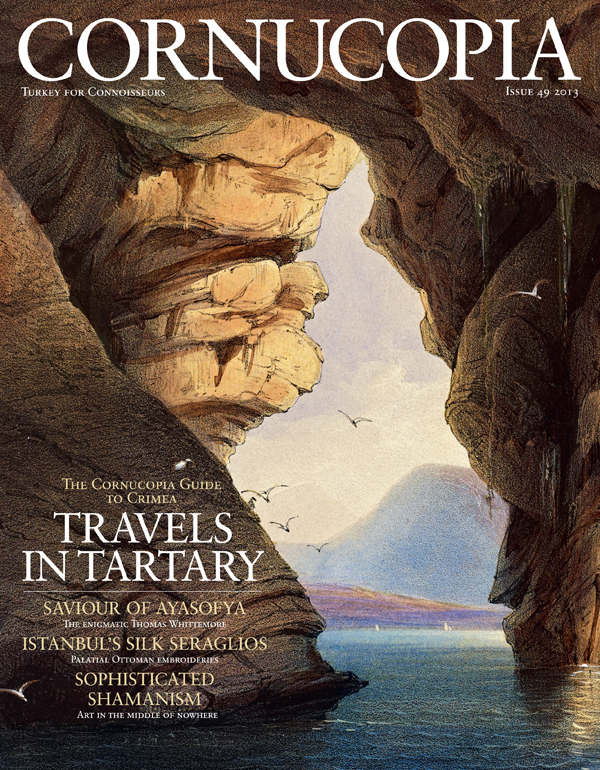Buy or gift a stand-alone digital subscription and get unlimited access to dozens of back issues for just £18.99 / $18.99 a year.
Please register at www.exacteditions.com/digital/cornucopia with your subscriber account number or contact subscriptions@cornucopia.net
Buy a digital subscription Go to the Digital EditionIn 1919 the Ukrainian artist Alexis Gritchenko fled Russia for Istanbul. Here he befriended Turkish artists and walked the streets, keeping a diary and making sketches, then applying ‘dynamos’ of colour. A new exhibition throws light on his stay in the city. By Thomas Roueché and Rose Shepherd
On July 23, 1919, as the Russian Civil War raged, Alexis Gritchenko, the maverick Ukrainian artist, opinionated lecturer and disputatious art critic, shrugged on a coat, grabbed a bag, padlocked his Moscow studio and, before heading to the station, wrote on the door: “There are no weapons here! Preserve it, please.”
“It” – a body of work of more than 500 canvases – would be impounded and cut up for use by students, “butchered”, as Gritchenko described the abomination two years later when he learnt of it in Paris. “How am I to reconcile myself to the complete disappearance of half of my life, my conscious, concrete, spiritual life?!”
But in that July his only instinct was to flee before a “spiritual trap” closed on him, obedient to an inner voice that urged: “Leave everything before it’s too late.” He seems to have had no clear destination in mind. “People usually jump into one of the raging streams, hoping their good fortune will toss them onto a nice welcoming shore. That was how one day I found myself under the minarets of Istanbul.”
Alexis Gritchenko: The Constantinople Years, an exhibition at Meşher (the Vehbi Koç Foundation’s gallery space on İstiklâl Caddesi), celebrates the artist’s sojourn in Turkey, a time of great trials, but also of some of his most inspired work.
READ THE FULL ARTICLE ONLINE (subscribers only)
● ‘Alexis Gritchenko – The Constantinople Years’ is at Meşher, Istanbul (scheduled to reopen September–November), mesher.org
FURTHER READING ● The catalogue, by Ayşenur Güler and Vita Susak (Vehbi Koç Foundation), £20. ● ‘Alexis Gritchenko: Dynamocolor’, by Vita Susak (Rodovid, Kyiv, 2017), £60. Order both books from cornucopia.net
A shared fascination with the Roman Empire impelled Britain’s greatest photographer, Sir Donald McCullin, to join the writer Barnaby Rogerson on a foray to the Troad to capture Rome’s Aegean legacy
Roger Norman looks back over the life of the late historian and writer Norman Stone – always unconventional, sometimes difficult, frequently mischievous – who, after less-than-happy times teaching at Oxford and Cambridge and a stint as an adviser to Margaret Thatcher, chose to make his home in Turkey
Centuries ago, travellers to Turkey were amazed by a new, uplifting taste sensation: the sherbet, flowery or fruity, and served with ice. Berrin Torolsan traces the history of sherbets and the sorbets made from them, and serves up an irresistible array of cooling summery treats
Istanbul without coffee houses is a day without sun. It was here that they were born, and they are still as individual and interesting as their clientele. Savour them while you can, says Andrew Finkel. Photo essay by Monica Fritz
The botanist Andrew Byfield relives the happy days on Bozdağ, in the Taurus Mountains. Flowers thrive there in the harsh climate on bare limestone cliffs and in fractured gullies, and cedar of Lebanon and black pine brave all that nature can throw at them
Can ingenious new ideas coupled with old country wisdom stave off the long-predicted death of the Anatolian village? We sent two keen conservationists to Turkey’s lake district. The writer Nicholas Haslam found reasons for hope. The photographer Paul Veysseyre captured the poignant beauty of its tumbledown houses



Cornucopia works in partnership with the digital publishing platform Exact Editions to offer individual and institutional subscribers unlimited access to a searchable archive of fascinating back issues and every newly published issue. The digital edition of Cornucopia is available cross-platform on web, iOS and Android and offers a comprehensive search function, allowing the title’s cultural content to be delved into at the touch of a button.
Digital Subscription: £18.99 / $18.99 (1 year)
Subscribe now